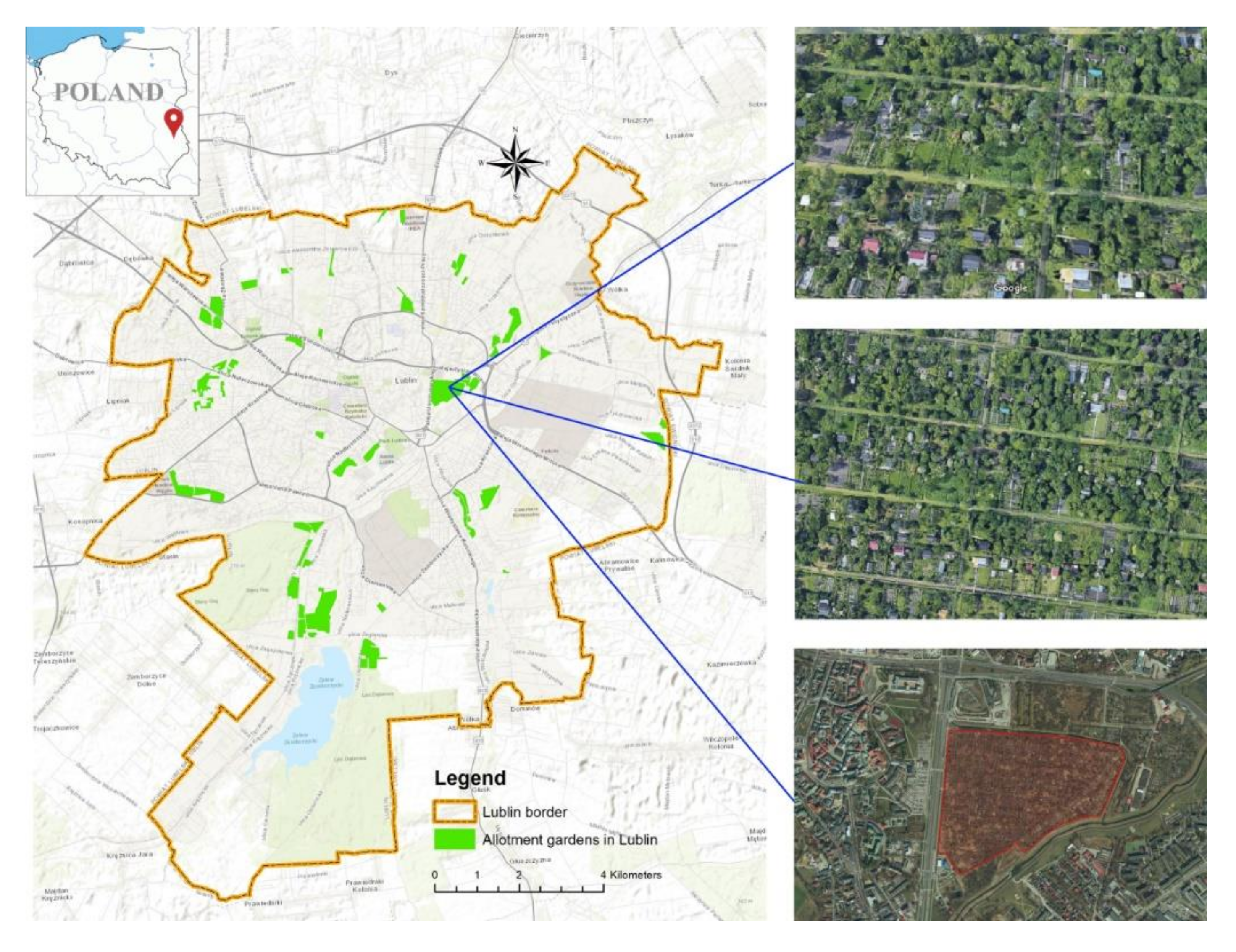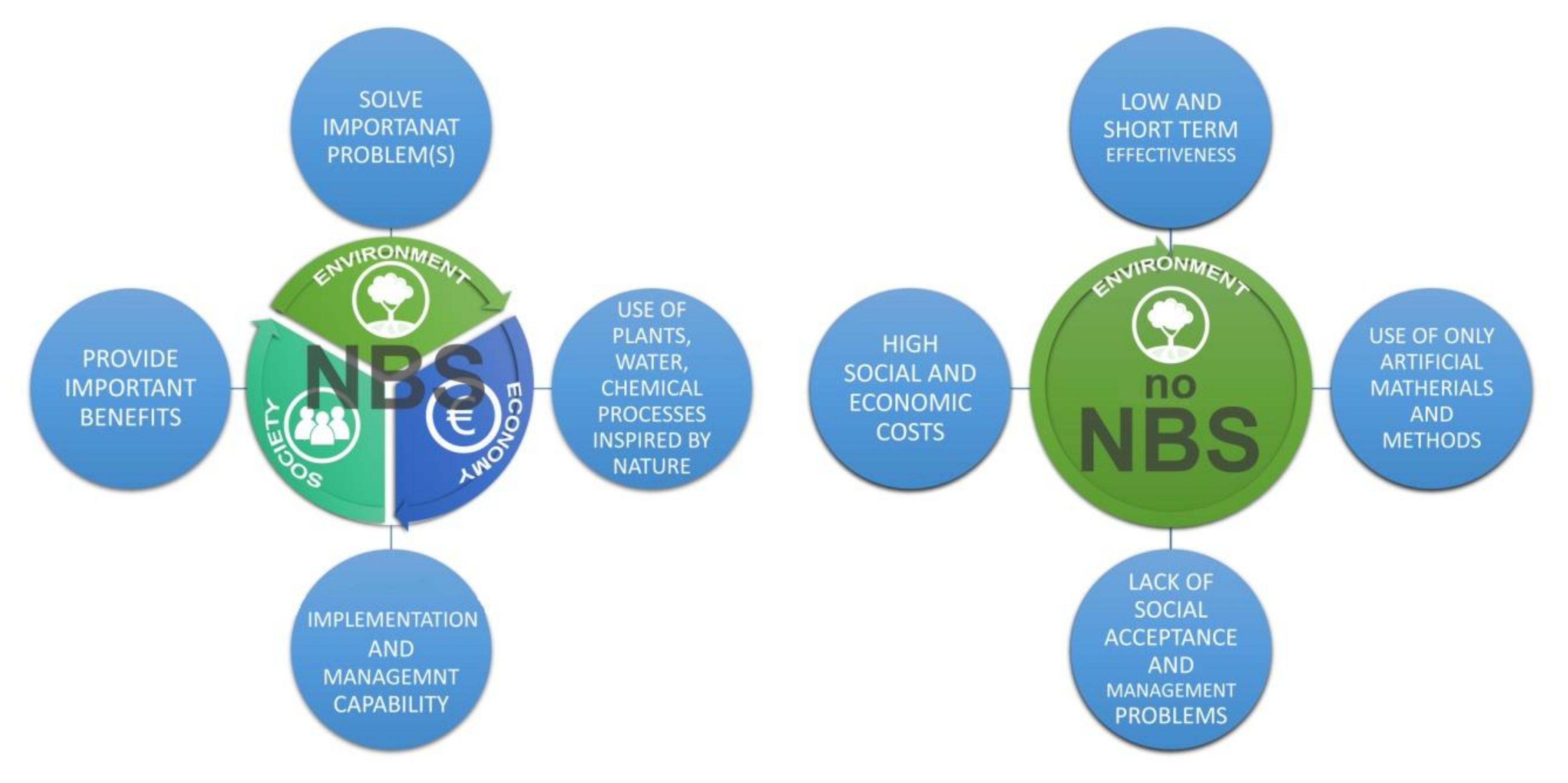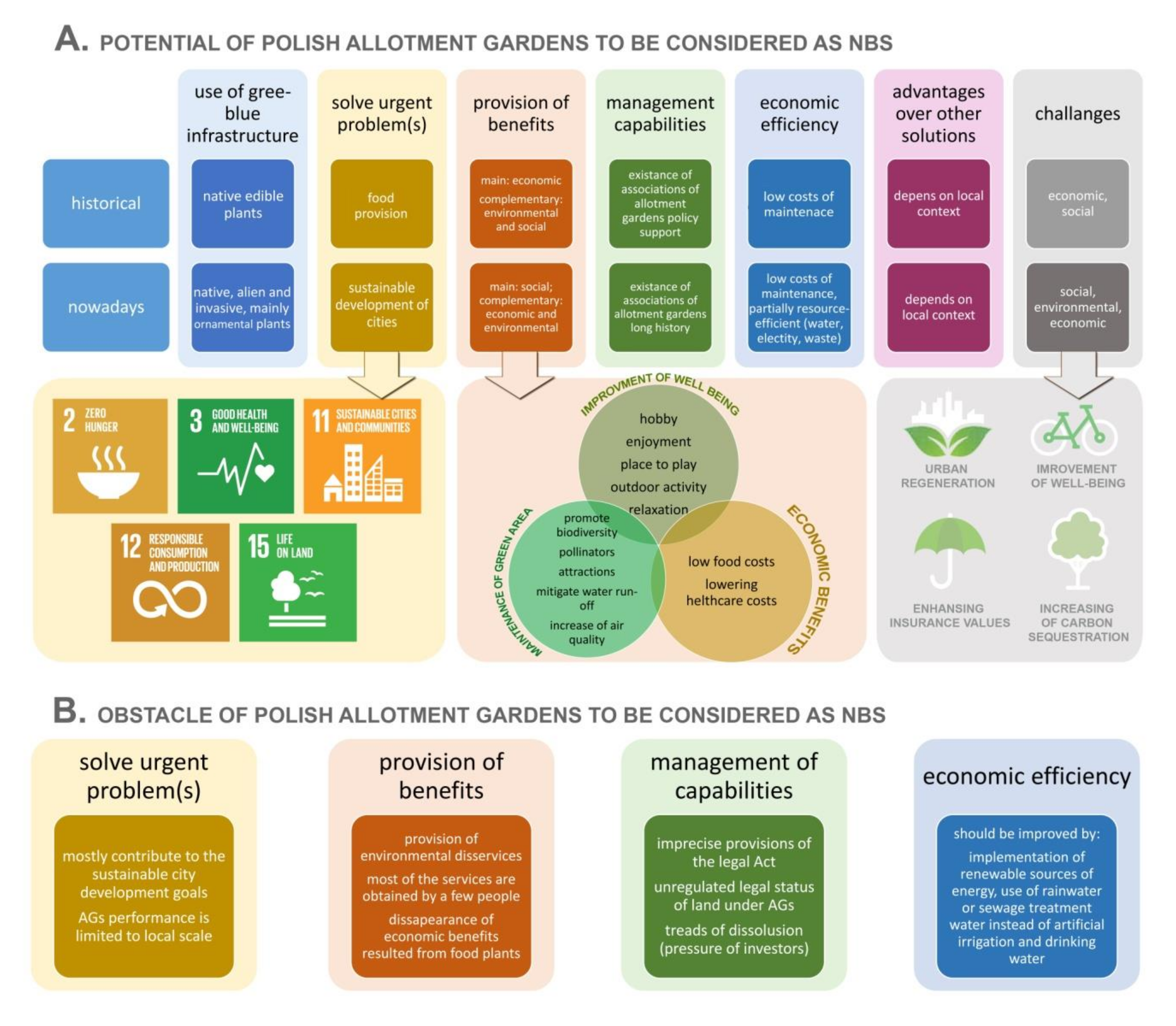Can Allotment Gardens (AGs) Be Considered an Example of Nature-Based Solutions (NBS) Based on the Use of Historical Green Infrastructure?
Abstract
1. Introduction
1.1. Environmental Pillar
1.2. Social Pillar
1.3. Economic Pillar
2. The Aim of the Paper
3. Materials and Methods
3.1. Case Study Characteristic: Polish Allotment Gardens (AGs)
3.2. Method of Research
4. Results
4.1. Key Features of NBSs
- NBSs are based on the use of blue and green infrastructure
- NBSs solve urgent problem(s)
- NBSs provide multiple benefits.
- NBSs possess implementation and management capabilities
- NBSs are economically efficient
- NBSs exceed other possible solution(s) (Table 3)
4.2. Research Questions
- How do AGs use blue and green infrastructure?
- What problem(s) do AGs solve today?
- What kind of benefits do AGs provide?
- Do AGs possess implementation and management capabilities?
- Can AGs be treated as economically efficient?
- What are the advantages of AGs versus other possible solution(s)?
4.3. Possibilities and Obstacles for Considering Polish AGs as an NBS Based on the Use of Historical Infrastructure
4.3.1. How Do AGs Use Blue and Green Infrastructure?
4.3.2. What Problem(s) Do AGs Solve Today?
4.3.3. What Kind of Benefits Do AGs Provide?
4.3.4. Can AGs Be Treated as Economically Efficient?
4.3.5. What Are the Environmental/Social/Economic Advantages and Disadvantages of AGs Versus Other Possible Solution(s)?
5. Discussion
6. Conclusions
Author Contributions
Funding
Informed Consent Statement
Data Availability Statement
Conflicts of Interest
References
- Nesshöver, C.; Assmuth, T.; Irvine, K.N.; Rusch, G.M.; Waylen, K.A.; Delbaere, B.; Haase, D.; Jones-Walters, L.; Keune, H.; Kovacs, E.; et al. The science, policy and practice of nature-based solutions: An interdisciplinary perspective. Sci. Total Environ. 2017, 579, 1215–1227. [Google Scholar] [CrossRef] [PubMed]
- US Army Corps of Engineers. CWTS 2013-3—Coastal Risk Reduction and Resilience. Civil Works Directorate; US Army Corps of Engineers: Washington, DC, USA, 2013.
- Ferreira, V.; Barreira, A.P.; Loures, L.; Antunes, D.; Panagopoulos, T. Stakeholders’ engagement on nature-based solutions: A systematic literature review. Sustainability 2020, 12, 640. [Google Scholar] [CrossRef]
- Kabisch, N.; van den Bosch, M.; Lafortezza, R. The health benefits of nature-based solutions to urbanization challenges for children and the elderly—A systematic review. Environ. Res. 2017, 159, 362–373. [Google Scholar] [CrossRef] [PubMed]
- Xing, Y.; Jones, P.; Donnison, I. Characterization of nature-based solutions for the built environment. Sustainability 2017, 9, 149. [Google Scholar] [CrossRef]
- Xie, L.; Bulkeley, H. Nature-based solutions for urban biodiversity governance. Environ. Sci. Policy 2020, 110, 77–87. [Google Scholar] [CrossRef]
- Frantzeskaki, N. Seven lessons for panning nature-based solutions in cities. Environ. Sci. Policy 2019, 93, 101–111. [Google Scholar] [CrossRef]
- Keesstra, S.; Nunes, J.; Novara, A.; Finger, D.; Avelar, D.; Kalantari, Z.; Cerdà, A. The superior effect of nature-based solutions in land management for enhancing ecosystem services. Sci. Total Environ. 2018, 610–611, 997–1009. [Google Scholar] [CrossRef]
- European Commission. Towards an EU Research and Innovation Policy Agenda for Nature-Based Solutions and Re-Naturing Cities; European Commission: Brussels, Belgium, 2015. [Google Scholar]
- Ershad Sarabi, S.; Han, Q.; LRomme, A.G.; de Vries, B.; Wendling, L. Key enablers of and barriers to the uptake and implementation of nature-based solutions in urban settings: A review. Resources 2019, 8, 121. [Google Scholar] [CrossRef]
- Neumayer, E. Week Versus Strong Sustainability: Exploring the Limits of Two Opposing Paradigms; Edward Elgar Publishing: Cheltenham, UK, 2003. [Google Scholar]
- Parker, J.; de Baro, M.E.Z. Green infrastructure in the urban environment: A systematic quantitative review. Sustainability 2019, 11, 3182. [Google Scholar] [CrossRef]
- Parker, J.; Simpson, G.D. Public green infrastructure contributes to city livability: A systematic quantitative review. Land 2018, 7, 161. [Google Scholar] [CrossRef]
- Venkataramanan, V.; Packman, A.I.; Peters, D.R.; Lopez, D.; McCuskey, D.J.; McDonald, R.I.; Young, S.L. A systematic review of the human health and social well-being outcomes of green infrastructure for stormwater and flood management. J. Environ. Manag. 2019, 246, 868–880. [Google Scholar] [CrossRef] [PubMed]
- Sowińska-Świerkosz, B. Critical review of landscape-based surrogate measures of plant diversity. Landsc. Res. 2020, 45, 819–840. [Google Scholar] [CrossRef]
- Zuniga-Teran, A.; Gerlak, A. A multidisciplinary approach to analyzing questions of justice issues in urban greenspace. Sustainability 2019, 11, 55. [Google Scholar] [CrossRef]
- Raymond, C.M.; Frantzeskaki, N.; Kabisch, N.; Berry, P.; Breil, M.; Nita, M.R.; Calfapietra, C. A framework for assessing and implementing the co-benefits of nature-based solutions in urban areas. Environ. Sci. Policy 2017, 77, 15–24. [Google Scholar] [CrossRef]
- Raymond, C.M.; Breil, M.; Nita, M.R.; Kabisch, N.; de Bel, M.; Enzi, V.; Berry, P. An Impact Evaluation Framework to Support Planning and Evaluation of Nature-based Solutions Projects. Report Prepared by the EKLIPSE Expert Working Group on Nature-based Solutions to Promote Climate Resilience in Urban Areas; Centre for Ecology and Hydrology: Wallingford, UK, 2017. [Google Scholar]
- Sang, A.O.; Knez, I.; Gunnarsson, B.; Hedblom, M. The effects of naturalness, gender, and age on how urban green space is perceived and used. Urban For. Urban Green. 2016, 18, 268–276. [Google Scholar] [CrossRef]
- Vujcic, M.; Tomicevic-Dubljevic, J.; Grbic, M.; Lecic-Tosevski, D.; Vukovic, O.; Toskovic, O. Nature based solution for improving mental health and well-being in urban areas. Environ Res. 2017, 158, 385–392. [Google Scholar] [CrossRef]
- Young, Y.E.; Passarelli, S.; Lovell, R.; Ringler, C. Gendered perspectives of ecosystem services: A systematic review. Ecosyst. Serv. 2018, 31. [Google Scholar] [CrossRef]
- Calvet-Mir, L.; March, H.; Corbacho-Monné, D.; Gómez-Baggethun, E.; Reyes-García, V. Home garden ecosystem services valuation through a gender lens: A case study in the Catalan Pyrenees. Sustainability 2016, 8, 718. [Google Scholar] [CrossRef]
- Martín-López, B.; Iniesta-Arandia, I.; García-Llorente, M.; Palomo, I.; Casado-Arzuaga, I.; Amo, D.; Gómez-Baggethun, E.; Oteros-Rozas, E.; Palacios-Agundez, I.; Willaarts, B.; et al. Uncovering ecosystem service bundles through social preferences. PLoS ONE 2012, 7, e38970. [Google Scholar] [CrossRef]
- Jefferson, R.L.; Bailey, I.; Richards, J.P.; Attrill, M.J. Public perceptions of the UK marine environment. Mar. Policy 2014, 43, 327–337. [Google Scholar] [CrossRef]
- Bush, J.; Doyon, A. Building urban resilience with nature-based solutions: How can urban planning contribute? Cities 2019, 95, 102483. [Google Scholar] [CrossRef]
- Faivre, N.; Fritz, M.; Freitas, T.; de Boissezon, B.; Vandewoestijne, S. Nature-based solutions in the EU: Innovating with nature to address social, economic and environmental challenges. Environ. Res. 2017, 159, 509–518. [Google Scholar] [CrossRef] [PubMed]
- Maes, J.; Jacobs, S. Nature-based solutions for Europe’s sustainable development. Conserv. Lett. 2017, 10, 121–124. [Google Scholar] [CrossRef]
- Duś, E. Recreational use and health functions of allotments gardens in the Katowice conurbation, Poland. Environ. Socio Econ. Stud. 2014, 2, 16–25. [Google Scholar] [CrossRef]
- Pawlikowska-Piechotka, A. Tradition of Allotment Gardens in Poland; Novae Res: Gdynia, Poland, 2010; 104p, ISBN 978-8361194118. (In Polish) [Google Scholar]
- Barthel, S.; Parker, J.; Ernstson, H. Food and green space in cities: A resilience lens on gardens and urban environmental movements. Urban Stud. 2013, 52, 1321–1338. [Google Scholar] [CrossRef]
- Henkel, M. 21st Century Homestead. Sustainable Agriculture; Lulu Press: Morrisville, CN, USA, 2015; pp. 1–306. [Google Scholar]
- Klepacki, P.; Kujawska, M. Urban allotment gardens in Poland: Implications for botanical and landscape diversity. J. Ethnobiol. 2018, 38, 123–137. [Google Scholar] [CrossRef]
- Szkup, R. Use of Family Allotment Gardens by a Metropolitan Community; Wydawnictwo Uniwersytetu Łódzkiego: Łódź, Poland, 2013; p. 246, (In Polish). Available online: https://wydawnictwo.uni.lodz.pl/produkt/uzytkowanie-rodzinnych-ogrodow-dzialkowych-rod-przez-spolecznosc-wielkomiejska/ (accessed on 12 January 2021).
- Poniży, L.; Stachura, K. Future of allotment gardens in the context of CITY spatial policy—A case study of Poznań. Queastiones Geogr. 2017, 36, 121–127. [Google Scholar] [CrossRef]
- Moskalonek, Z.; Połom, M.; Puzdrakiewicz, K. Changes in the function of allotment gardens in an attractive location based on the example of tri-city in Poland. Land 2020, 9, 464. [Google Scholar] [CrossRef]
- Duś, E. Allotment gardens and spatial development—Two case studies from the Katowice conurbation, Poland. Environ. Soc.-Econ. Stud. 2013, 1, 41–51. [Google Scholar] [CrossRef]
- Krauze, K.; Wagner, I. From classical water-ecosystem theories to nature-based solutions—Contextualizing nature-based solutions for sustainable city. Sci. Total Environ. 2019, 655, 697–706. [Google Scholar] [CrossRef]
- Van der Jagt, A.P.N.; Szaraz, L.R.; Delshammar, T.; Cvejić, R.; Santos, A.; Goodness, J.; Buijs, A. Cultivating nature-based solutions: The governance of communal urban gardens in the European Union. Environ. Resour. 2017, 159, 264–275. [Google Scholar] [CrossRef] [PubMed]
- Eggermont, H.; Balian, E.; Azevedo, J.M.N.; Beumer, V.; Brodin, T.; Claudet, J.; Fady, B.; Grube, M.; Keune, H.; Lamarque, P. Nature-based solutions: New influence for environmental management and research in Europe. GAIA 2015, 24, 243–248. [Google Scholar] [CrossRef]
- Bartłomiejski, R.; Kowalewski, M. Polish urban allotment gardens as ‘slow city’ enclaves. Sustainability 2019, 11, 3228. [Google Scholar] [CrossRef]
- Borysiak, J.; Mizgajski, A.; Speak, A. Floral biodiversity of allotment gardens and its contribution to urban green infrastructure. Ekon. Sr. 2016, 4, 292–306. [Google Scholar] [CrossRef]
- Jasionkowski, R.; Lewandowska-Czarnecka, A. The potential of urban agriculture for sustainability of cities in Poland. Ecol. Quest. 2016, 24, 59–64. [Google Scholar] [CrossRef]
- Kabala, C.; Chodak, T.; Szerszen, L.; Karczewska, A.; Szopka, K.; Fratczak, K. Factors influencing the concentration of havy metals in soils of allotment garden in the city of Wroclaw, Poland. Fresenius Environ. Bull. 2009, 18, 1118–1124. [Google Scholar]
- Trembecka, A.; Kwartnik-Pruc, A. An analysis of the changes in the structure of allotment gardens in Poland. Sustainability 2018, 10, 3829. [Google Scholar] [CrossRef]
- Pawlikowska-Piechotka, A. Urban greens and sustainable land policy management (case study in Warsaw). European Cty. 2012, 4, 251–268. [Google Scholar] [CrossRef]
- Dymek, D.; Bednorz, L. Zagospodarowanie Rodzinnych Ogórdków Dzaiłkowych (ROD) na przykładzie ROD im. Józefa Chociszewskiego w Poznaniu. Studia Miej. 2017, 25, 133–147. (In Polish) [Google Scholar] [CrossRef]
- Speak, A.F.; Mizgajski, A.; Borysiak, J. Allotment gardens and parks: Provision of ecosystem services with an emphasis on biodiversity. Urban For. Urban Green. 2015, 14, 772–781. [Google Scholar] [CrossRef]
- Kosmala, M. Ogrody Działkowe w Miastach—Bariera czy Wartość? (Allotment Gardens in Cities—Barrier or Value?); Polskie Zrzeszenie Inżynierów i Techników Sanitarnych: Toruń, Poland, 2013; ISBN 978-83-935740-0-1. (In Polish) [Google Scholar]
- Pawlikowska-Piechotka, A. Rodzinne ogrody działkowe w Warszawie tradycja i współczesność. Maz. Studia Reg. 2019, 29, 67–73. (In Polish) [Google Scholar]
- Kronenberg, J.; Bergier, T.; Maliszewska, K. The challenge of innovation disunion: Nature-based solutions in Poland. In Nature-Based Solutions to Climate Change Adaptation in Urban Areas: Linkages between Science, Policy and Practice; Kabisch, N., Korn, H., Stadler, J., Bonn, A., Eds.; Springer: Cham, Switzerland, 2017; pp. 291–305. [Google Scholar]
- Albert, C.; Schröter, B.; Haase, D.; Brillinger, M.; Henze, J.; Herrmann, S.; Gottwald, S.; Guerrero, P.; Nicolas, C.; Matzdorf, B. Addressing societal challenges through nature-based solutions: How can landscape planning and governance research contribute? Landsc. Urban Plan. 2019, 182, 12–21. [Google Scholar] [CrossRef]
- Santoro, S.; Pluchinotta, I.; Pagano, A.; Pengal, P.; Cokan, B.; Giordano, R. Assessing stakeholders’ risk perception to promote Nature Based Solutions as flood protection strategies: The case of the Glinščica river (Slovenia). Sci. Total Environ. 2019, 655, 188–201. [Google Scholar] [CrossRef] [PubMed]
- Chausson, A.; Turner, B.; Seddon, D.; Chabaneix, N.; Girardin, C.A.; Kapos, V.; Seddon, N. Mapping the effectiveness of nature-based solutions for climate change adaptation. Glob. Chang. Biol. 2020, 26, 6134–6155. [Google Scholar] [CrossRef] [PubMed]
- Andersson, E.; Borgström, S.; McPhearson, T. Double insurance in dealing with extremes: Ecological and social factors for making nature-based solutions last. In Nature-Based Solutions to Climate Change Adaptation in Urban Areas: Linkages between Science, Policy and Practice; Kabisch, N., Korn, H., Stadler, J., Bonn, A., Eds.; Springer: Cham, Switzerland, 2017; pp. 51–64. [Google Scholar]
- The 2030 Agenda for Sustainable Development. 2015. Available online: https://sustainabledevelopment.un.org/?menu=1300 (accessed on 12 January 2021).
- Gough, M.Z.; Accordino, J. Public gardens as sustainable community development partners: Motivations, perceived benefits, and challenges. Urban Aff. Rev. 2013, 49, 851–887. [Google Scholar] [CrossRef]
- Rowinski, R.; Morgulec-Adamowicz, N.; Ogonowska-Słodownik, A.; Dąbrowski, A.; Richley, G.P. Participation in leisure activities and tourism among older people with and without disabilities in Poland. Arch. Gerontol. Geriatr. 2017, 73, 82–88. [Google Scholar] [CrossRef] [PubMed]
- Duś, E. Tendencje zmian w rolniczym użytkowaniu ogrodów działkowych w świetle zagrożeń ekologicznych. In Rolnictwo na Obszarach Wielofunkcyjnych; Materiały X Seminarium Geograficzno-Rolniczego: Kielce, Poland, 1993; pp. 35–41. (In Polish) [Google Scholar]
- Duś, E. Przeszłość i współczesny stan ogrodnictwa działkowego w Chorzowie. Zesz. Chorzowskie 1997, 1, 135–151. (In Polish) [Google Scholar]
- Escobedo, F.J.; Kroeger, T.; Wagner, J.E. Urban forests and pollution mitigation: Analyzing ecosystem services and disservices. Environ. Pollut. 2011, 159, 2078–2087. [Google Scholar] [CrossRef]
- Nesbitt, L.; Hotte, N.; Barron, S.; Cowan, J.; Sheppard, S.R.J. The social and economic value of cultural ecosystem services provided by urban forests in North America: A review and suggestions for future research. Urban For. Urban Green. 2017, 25, 103–111. [Google Scholar] [CrossRef]
- Referowska-Chodak, E. Management and social problems linked to the human use of European urban and suburban forests. Forests 2019, 10, 964. [Google Scholar] [CrossRef]
- Haase, D.; Kabisch, N.; Haase, A. Endless urban growth? On the mismatch of population, household and urban land area growth and its effects on the urban debate. PLoS ONE 2013, 8, e66531. [Google Scholar] [CrossRef] [PubMed]
- Hanson, H.I.; Wickenberg, B.; Olsson, J.A. Working on the boundaries—How do science use and interpret the nature-based solution concept? Land Use Policy 2020, 90, 104302. [Google Scholar] [CrossRef]
- Lafortezza, R.; Chen, J.; Van den Bosch, C.; Randrup, T. Nature-based solutions for resilient landscapes and cities. Environ. Res. 2017, 165, 431–441. [Google Scholar] [CrossRef] [PubMed]
- Langemeyer, J.; Camps-Calvet, M.; Calvet-Mir, L.; Barthel, S.; Gómez-Baggethun, E. Stewardship of urban ecosystem services: Understanding the value(s) of urban gardens in Barcelona. Landsc. Urban Plan. 2018, 170, 79–89. [Google Scholar] [CrossRef]
- Le Guern, C.; Jean-Soro, L.; Béchet, B.; Lebeau, T.; Bouquet, D. Management initiatives in support of the soil quality of urban allotment gardens: Examples from Nantes (France). Land Degrad. Dev. 2018, 29, 3681–3692. [Google Scholar] [CrossRef]




| Papers | Thematic Scope of Paper | Spatial Scope of Paper | Research Questions | |||||
|---|---|---|---|---|---|---|---|---|
| How do AGs Use Blue and Green Infrastructure? | What Problem(s) do AGs Solve Today? | What Kind of Benefits do AGs Provide? | Do AGs Possess Implementation and Management Capabilities? | Can AGs be Treated as Economically Efficient? | What are the Advantages of AGs versus Other Possible Solution(s)? | |||
| English Language Papers | ||||||||
| Bartłomiejski & Kowalewski 2019 [40] | AGs contribution to the “slow city” concept | The five largest Polish cities: Warszawa, Kraków, Szczecin, Łódź, Wrocław | √ | √ | √ | |||
| Borysiak et al. 2016 [41] | Floral biodiversity of AGs | The city of Poznań (Poland) | √ | |||||
| Duś 2014 [28] | Recreational use and health functions | Katowice conurbation (Poland) | √ | √ | ||||
| Jasionkowski and Lewandowska-Czarnecka 2016 [42] | Possibilities of food production | Polish cities in general | √ | |||||
| Kabala et al. 2009 [43] | Concentration of heavy metals in soils of AGs | The city of Wroclaw (Poland) | √ | |||||
| Klepacki & Kujawska 2018 [32] | Botanical and landscape diversity | Three Polish cities: Wrocław, Katowice, Cracow | √ | √ | ||||
| Moskalonek et al. 2020 [35] | Changes in the function of AGs in attractive location | Tri-City (Poland) | √ | √ | ||||
| Trembecka, & Kwartnik-Pruc 2018 [44] | Spatial distribution of AGs and their legal status | The city of Cracow (Poland) | √ | √ | √ | |||
| Pawlikowska-Piechotka 2012 [45] | Policy and management of AGs | The city of Warsaw (Poland) | √ | √ | √ | |||
| Poniży & Stachura 2017 [34] | Urban spatial policy towards allotment gardening | The city of Poznań (Poland) | √ | |||||
| Rowiński et al. 2017 [46] | AGs as recreation places for older people | Polish cities in general | √ | |||||
| Speak et al. 2015 [47] | Ecosystem services provided by AGs | The cities of Manchester (UK) and Poznań (Poland) | √ | √ | ||||
| Polish Language Papers | ||||||||
| Dymek, Bednorz 2017 [46] | Development of AGs | The city of Poznań (Poland) | √ | |||||
| Kosmala red. 2013 [48] | The reasons for the location of AGs in the city structure | The city of Łódź (Poland) | √ | √ | √ | √ | √ | |
| Pawlikowska-Piechotka 2010 [29] | AGs as a form of recreational development | Polish cities in general | √ | √ | √ | |||
| Pawlikowska-Piechotka 2019 [49] | History and current use | The city of Warsaw (Poland) | √ | √ | √ | √ | ||
| Definitions and Goals of NBSs According to Selected Papers |
|---|
| “Actions address environmental, social, and economic challenges simultaneously by maximizing the benefits provided by nature” [9]. |
| “Conscious use of nature to help urban inhabitants address various environmental, social, and economic challenges” [50]. |
| “A promising means to address a number of societal challenges arising from climate change and urbanization, with multiple social, environmental, and economic co-benefits” [10]. |
| Action “inspired by, supported by, or copied from nature” [9] (EC 2015). |
| “Mimicking nature should be the dominant approach for using NBSs to restore the urban scape and city ecosystem services” [37]. “Multifunctional green interventions delivering upon the social, environmental, and economic pillars of suitable development” [38]. |
| “Actions that alleviate a well-defined societal challenge employ ecosystem processes of spatial, blue, and green infrastructure networks, and are embedded within viable governance or business models for implementation” [51]. |
| “Enhancing sustainable urbanisation; restoring degraded ecosystems; developing climate change adaptation and mitigation; and improving risk management and resilience” [9]. |
| “Nature-based solutions support economic development” [9]. |
| Key Features of NBSs | Explanation |
|---|---|
| Utilization of Blue/Green Infrastructure | The use of nature, by adopting and copying it, constitutes the basis of NBS concept [9]. The utilization of plants, water, and/or natural chemical processes such as phytoremediation and phytostabilization is a priority rather than a supplement to engineering infrastructure [50]. An NBS may be based on both a pure green solution or a solution that merges natural processes and grey infrastructure [39]. |
| Solving Urgent (Global) Problems | NBSs have the potential to address urgent and generally global challenges by dealing with aspects such as sustainable urbanization, restoration of degraded ecosystems, climate change adaptation and mitigation, improvement of risk management and resilience, food security, disaster risk reduction, and economic development [9,10]. |
| Provision of Multiple Services | NBSs should be treated as a dynamic scheme of ecosystem service provisioning, offering multiple benefits simultaneously [9]. They include three pillars of sustainability: environmental (e.g., the promotion of biodiversity, decrease of flooding risk, enhancement of water resilience, and to the climate changes adaptations and carbon sequestration); social (improvement of mental and physical health, social cohesion, and portion of outdoor activity); and economic (production of low-cost food, creation of green jobs, use of the renewable sources of energy, and reduction of watering and energy costs) [3,10,13]. |
| Implementation and Management Capabilities | Any intervention considered as nature-based requires flexible and transparent models of governance to measure, verify, replicate, maintain, and if necessary alter and improve the solutions adopted [7,27,37]. It includes both the use of existing policy framework and the changes in policy, legislation, and spatial planning [52]. |
| Economic Efficiency | NBSs have a potential to be of high economic efficiency by promoting “transitions” from a resource-intensive growth model towards a more resource-efficient model. This efficiency, in relation to the NBSs, means that the cost of a solution’s implementation, maintenance, or transformation should not exceed the potential environmental and social benefits [5,9,26,27]. |
| NBSs’ Excess Other Possible Solution(s) | A given implemented NBS should exceed other possible solutions in terms of their effectiveness in relation to the environmental, social, and economic aspects resulting from the local conditions [9]. There is a lack of site-specific studies, however, on the effectiveness of these interventions compared to alternatives ones [53]. |
| Features that exclude a solution from being considered as an NBS: | |
| |
| Examples include: protection actions aimed at the maintenance of endangered plant species in urban environments; developing a recreational park in a place of rare multi-species meadows; development of a concrete dam against flooding; an exotic botanical park that needs continuous heating and watering; planting of non-drought-resistant plants that die each year and therefore need to be planted again. | |
| What Can Be Done | Obstacles that Are Difficult to Remove |
|---|---|
| Removal of the institutional barriers, including the introduction of legal acts precisely regulating all principles, and the adoption of land-use plans in order to ensure gardens’ future existence. | Removal of environmental inequalities (AGs by definition are owned by families and no trespassing is allowed). |
| Regulation of financial aspects (the introduction of the recompense law in the case of the dissolution of AGs and their obligations; the replacement of AGs with another element of urban greenery; regulation of fees) [44]. | Limitation of social arbitrariness (a top-down ban on the introduction of invasive species and the use of herbicides and pesticides cannot be imposed). |
| Ensuring stakeholders’ participation through elaborating the policy model involving government and non-government actors, including owners and other citizens. | |
| Intensification of multiple benefits (edible plants, more trees and fewer lawns, native and protected species, ponds, and educational function for the general public). | |
| Intensification of the implementation of renewable sources of energy (solar panels) | |
| The use of rainwater or treated sewage water instead of artificial irrigation and drinking water | |
| Transformation of abandoned AGs and their communal areas to urban parks (or even pocket gardens). | |
| Educational activities directed towards owners related to the environmental consequences of gardening practices. |
Publisher’s Note: MDPI stays neutral with regard to jurisdictional claims in published maps and institutional affiliations. |
© 2021 by the authors. Licensee MDPI, Basel, Switzerland. This article is an open access article distributed under the terms and conditions of the Creative Commons Attribution (CC BY) license (http://creativecommons.org/licenses/by/4.0/).
Share and Cite
Sowińska-Świerkosz, B.; Michalik-Śnieżek, M.; Bieske-Matejak, A. Can Allotment Gardens (AGs) Be Considered an Example of Nature-Based Solutions (NBS) Based on the Use of Historical Green Infrastructure? Sustainability 2021, 13, 835. https://doi.org/10.3390/su13020835
Sowińska-Świerkosz B, Michalik-Śnieżek M, Bieske-Matejak A. Can Allotment Gardens (AGs) Be Considered an Example of Nature-Based Solutions (NBS) Based on the Use of Historical Green Infrastructure? Sustainability. 2021; 13(2):835. https://doi.org/10.3390/su13020835
Chicago/Turabian StyleSowińska-Świerkosz, Barbara, Malwina Michalik-Śnieżek, and Alicja Bieske-Matejak. 2021. "Can Allotment Gardens (AGs) Be Considered an Example of Nature-Based Solutions (NBS) Based on the Use of Historical Green Infrastructure?" Sustainability 13, no. 2: 835. https://doi.org/10.3390/su13020835
APA StyleSowińska-Świerkosz, B., Michalik-Śnieżek, M., & Bieske-Matejak, A. (2021). Can Allotment Gardens (AGs) Be Considered an Example of Nature-Based Solutions (NBS) Based on the Use of Historical Green Infrastructure? Sustainability, 13(2), 835. https://doi.org/10.3390/su13020835




